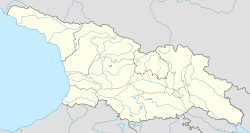Chiatura
|
Chiatura ჭიათურა |
|
|---|---|

The town of Chiatura.
|
|
| Location of Chiatura in Georgia | |
| Coordinates: 42°17′52″N 43°17′56″E / 42.29778°N 43.29889°E | |
| Country |
|
| Mkhare | Imereti |
| Population (2008) | |
| • Total | 19,587 |
| Time zone | Georgian Time (UTC+4) |
| Climate | Cfb |
|
|
Chiatura (Georgian: ჭიათურა) is a city in the Imereti region of Western Georgia. In 1989, it had a population of about 30,000.
The city is located inland, in a mountain valley on the banks of the Qvirila River.
In 1879 the Georgian poet Akaki Tsereteli explored the area in search of manganese and iron ores, discovering deposits in the area. After other intense explorations it was discovered that there are several layers of commercially exploitable manganese oxide, peroxide and carbonate with thickness varying between 0.2 m (0.66 ft) and 16 m (52 ft). The state set-up the JSC Chiaturmanganese company to manage and exploit the huge deposit. The gross-balance of workable manganese ores of all commercial categories is estimated as 239 million tonnes, which include manganese oxide ores (41.6%), carbonate ores (39%), and peroxide ores (19%). As a result, the company developed a rail link to transport manganese ore to the ferro-alloy plant in Zestaphoni, which operated today by Georgian Railways is fully electrified. Manganese production rose to 60% of global output by 1905.
In Chiatura are located the Tsereteli State Theater, 10 schools, Faculty of the Georgian Technical University, and the Mgvimevi Cathedral (10th-11th centuries). During the 1905 Russian Revolution Chiatura was the only Bolshevik stronghold in mostly Menshevik Georgia. 3,700 miners worked 18 hours a day sleeping in the mines, always covered in soot. They didn't even have baths. Joseph Stalin persuaded them to back Bolshevism during a debate with the Mensheviks. They preferred his simple 15-minute speech to his rivals' oratory. They called him "sergeant major Koba". He set up a printing press, protection racket and "red battle squads". Stalin put Vano Kiasashvili in charge of the armed miners. The mine owners actually sheltered him as he would protect them from thieves in return and he destroyed mines whose owners refused to pay up.
...
Wikipedia

